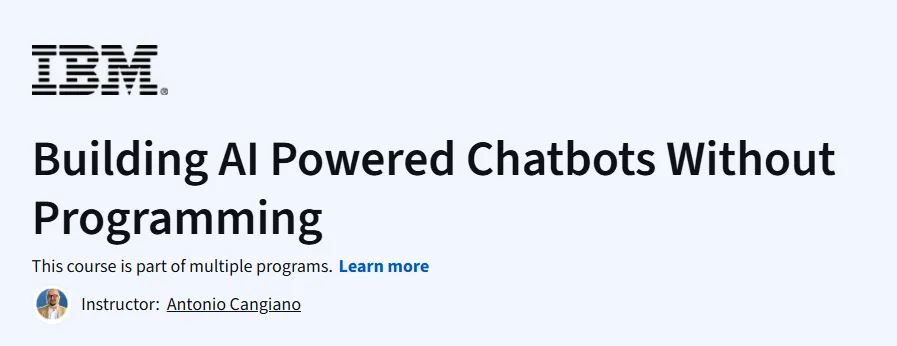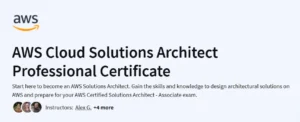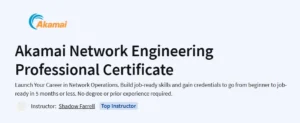What will you learn in Building AI Powered Chatbots Without Programming Course
Design conversational flows and user intents for AI-powered chatbots.
Integrate Large Language Models (e.g., OpenAI GPT) into chatbot backends.
Implement rich messaging features—buttons, carousels, and multimedia responses.
Deploy chatbots to multiple channels: web, mobile, and messaging platforms (Slack, WhatsApp).
Handle context, session management, and multi-turn conversations effectively.
Program Overview
Module 1: Introduction to AI Chatbots & Architecture
⏳ 1.5 hours
Topics: Evolution of chatbots, LLM basics, system architecture.
Hands-on: Sketch a high-level architecture for an AI chatbot using GPT APIs.
Module 2: Intent Recognition & Slot Filling
⏳ 2 hours
Topics: NLU concepts, training intent classifiers, extracting entities.
Hands-on: Build and evaluate an intent classifier; implement slot-filling logic.
Module 3: Conversational Flow Design
⏳ 2 hours
Topics: Dialogue state management, decision trees vs. generative approaches.
Hands-on: Create multi-turn flows with context variables in a chatbot framework.
Module 4: Integrating LLMs into Your Bot
⏳ 2 hours
Topics: Calling GPT/OpenAI APIs, prompt engineering, handling API responses.
Hands-on: Implement a middleware that formats user inputs into prompts and parses outputs.
Module 5: Rich Messaging & UI Components
⏳ 1.5 hours
Topics: Quick replies, carousels, buttons, images, and attachments.
Hands-on: Enhance your bot’s responses with interactive UI elements.
Module 6: Multi-Channel Deployment
⏳ 2 hours
Topics: Connecting to Slack, WhatsApp, and web chat widgets.
Hands-on: Deploy your chatbot to Slack and test real-time interactions.
Module 7: Testing, Analytics & Optimization
⏳ 1.5 hours
Topics: Unit testing, conversational QA, user metrics tracking, A/B testing.
Hands-on: Set up analytics dashboards and run a conversation-flow experiment.
Module 8: Security, Privacy & Compliance
⏳ 1 hour
Topics: Data handling, GDPR/CCPA considerations, input sanitization.
Hands-on: Implement logging and consent management for user data.
Get certificate
Job Outlook
AI chatbot developers and conversational UX designers are in high demand across e-commerce, customer support, and enterprise automation.
Roles include Conversational AI Engineer, Bot Developer, and Chatbot UX Specialist, with salaries ranging $90K–$130K USD.
Skills in LLM integration, prompt engineering, and multi-channel deployment open opportunities in startups and large tech firms.
Specification: Building AI Powered Chatbots Without Programming
|
FAQs
- Many modern platforms allow drag-and-drop chatbot building without writing code.
- You’ll still benefit from understanding logic flows and structured thinking.
- Technical familiarity (like APIs) can enhance your chatbot’s capabilities.
- No coding is required for the basics—advanced features may need some scripting.
- The course teaches you to use tools without relying on programming knowledge.
- Yes, most chatbot platforms support multi-channel deployment.
- Each platform may have unique integration requirements.
- The chatbot logic remains the same, only connectors differ.
- You’ll be able to test chatbots in real-time across platforms.
- Some channels may need approval (e.g., WhatsApp Business API).
- Conversational AI Engineer.
- Chatbot Developer for enterprises and startups.
- Customer Support Automation Specialist.
- Conversational UX Designer.
- AI Product Manager focusing on chatbot-driven solutions.
- Many chatbot frameworks integrate with multilingual NLP engines.
- Large Language Models (LLMs) like GPT handle multiple languages natively.
- You can train or configure bots for specific regional intents.
- Accent recognition depends more on speech-to-text accuracy.
- Proper testing ensures a smooth user experience across languages.
- Yes, if best practices for privacy are followed.
- Secure data handling methods like encryption are essential.
- GDPR/CCPA compliance ensures legal safeguards.
- Bots should not store sensitive data unnecessarily.
- Consent and transparency build user trust in chatbot interactions.





